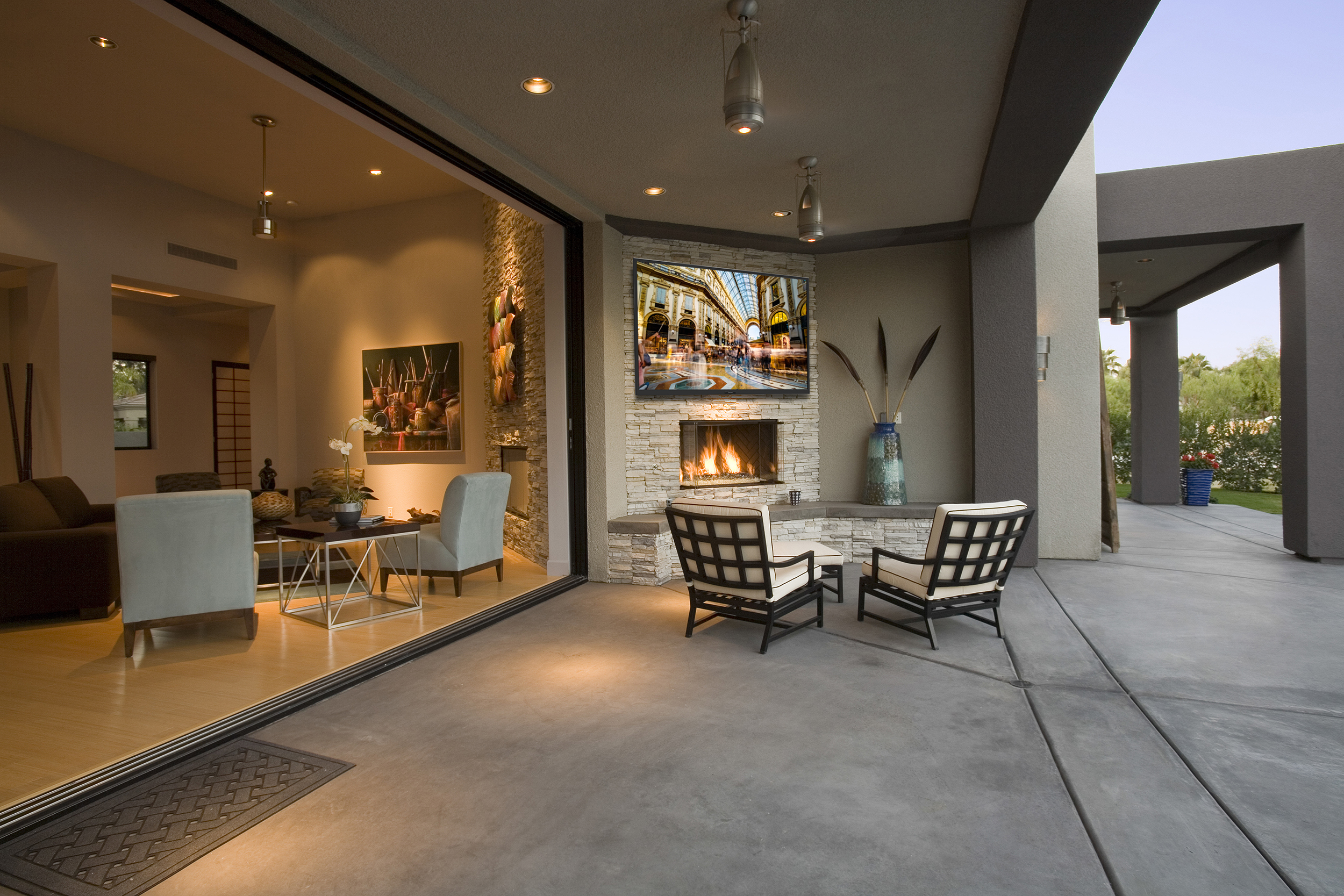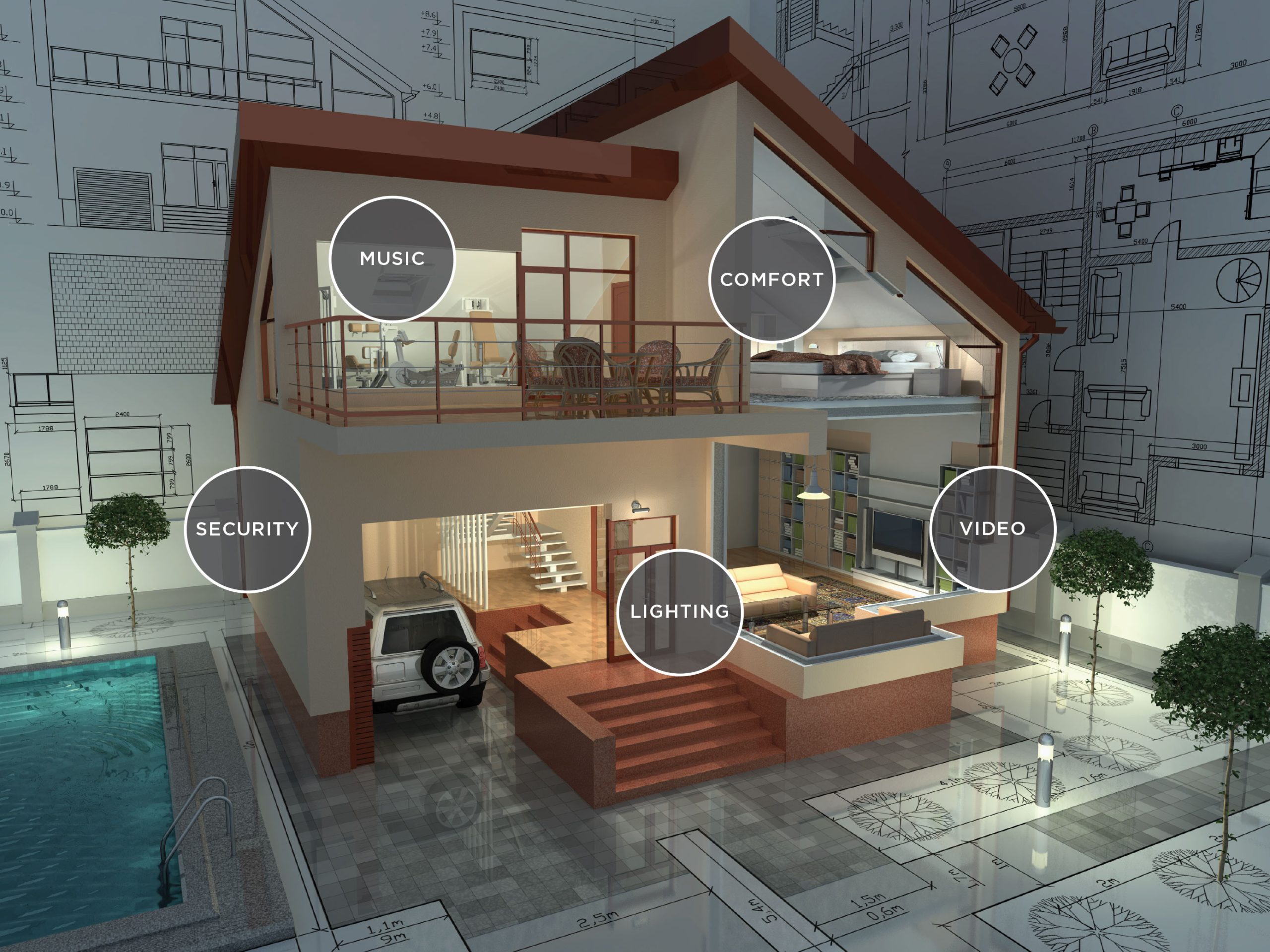How Does Home Automation Work?
Home automation works to transform ordinary homes into intelligent environments where devices and systems communicate seamlessly to enhance convenience, efficiency, and security. This technology integrates various components like lighting, heating, and security systems through a centralized network, enabling effortless control from a smartphone or voice-activated device. At Programmed Living, we specialize in designing home automation systems that adapt to and anticipate your needs, creating not just a smart home but a thoughtful one.
The evolution of home automation began with simple automated appliances and has since advanced to sophisticated networks that manage everything from climate to security, reflecting significant technological advancements over the decades. Today’s smart homes can learn from your habits and adjust themselves accordingly, offering unprecedented levels of comfort.
The importance of home automation is evident in its ability to enhance the quality of daily life. By automating routine tasks, residents experience greater convenience and can focus more on what truly matters. Additionally, smart systems significantly improve energy efficiency by optimizing the use of resources, leading to reduced utility bills and a lesser environmental impact. Furthermore, integrated security systems offer real-time surveillance and alerts, ensuring peace of mind. In modern living, where efficiency and security are paramount, home automation by Programmed Living stands as a critical enhancement to any home.

Components of Home Automation
Smart devices play a pivotal role in how home automation works, enhancing modern life by making daily activities more manageable. Key devices include smart lights that adjust based on the time of day, thermostats that learn your temperature preferences, and security cameras that provide real-time monitoring and alerts. Leading brands like Philips Hue, Nest for thermostats, and Arlo for security solutions are at the forefront, pushing the boundaries of what smart devices can achieve.
Control of these devices is streamlined through various interfaces. Smartphones and tablets remain the most common tools for interfacing with home automation systems, offering apps that bring control to your fingertips. Voice assistants like Amazon Alexa, Google Assistant, and Apple Siri allow for hands-free control, simplifying how you manage your home’s environment. Additionally, dedicated touch panels and keypads are installed in strategic locations around the home for direct control of the system without the need for a mobile device.
Connectivity is key in home automation, with technologies like Wi-Fi, Bluetooth, Zigbee, and Z-Wave facilitating communication between devices. Wi-Fi offers extensive range and high data rates, ideal for high-bandwidth devices like cameras, while Bluetooth is suited for closer-range, low-power tasks. Zigbee and Z-Wave specialize in creating reliable, low-energy networks for smaller devices, making them perfect for a mesh of sensors and switches throughout the home. Each technology presents its pros and cons, shaping the way devices interact and integrate to form a cohesive system.
How Home Automation Works
Home automation operates on foundational principles that allow for seamless functionality and interaction within smart environments, showcasing how home automation works. Central to these systems are sensors and actuators. Sensors detect changes in the environment, such as motion or temperature shifts, and actuators perform actions based on sensor data, such as turning on lights or adjusting thermostats. These elements work together under sophisticated control systems and algorithms that dictate how devices react in various scenarios, ensuring that actions are both timely and energy-efficient.
Data flow in home automation is vital for its operation. This flow begins with signal transmission, where sensors send data to a central hub or directly to other devices. Following transmission, the data undergoes processing, where decision-making algorithms assess the inputs and determine appropriate outputs. This can include turning off unnecessary lights or sending alerts if unexpected motion is detected when no one is home.
Integration and interoperability are critical to the effectiveness of home automation systems. It is essential for different devices and systems to communicate smoothly regardless of the manufacturer. Standards and protocols like IFTTT (If This Then That) and Thread play significant roles in this integration. IFTTT allows for the creation of conditional statements for device interactions, while Thread provides a reliable, low-power mesh networking protocol that ensures devices can interconnect within a smart home ecosystem. These technologies are pivotal in creating a versatile and user-friendly home automation system that enhances the functionality and comfort of living spaces.
Setting Up a Smart Home

When embarking on the journey of transforming a home into a smart environment, it is best to work with a professional who can help assess your needs during the planning and design phase. At Programmed Living, our professionals are expertly trained to understand your needs and make your lifestyle more functional. Homeowners’ specific needs and lifestyle goals can range from increasing security to enhancing energy efficiency or simply adding convenience to everyday tasks. Selecting the right technologies and devices involves considering factors such as compatibility, ease of use, and integration capabilities. It’s important to choose devices that not only address the homeowners’ primary concerns but also seamlessly work together within the existing infrastructure.
The installation process can vary significantly based on the complexity of the system and the homeowner’s technical expertise. DIY installation can be a cost-effective option for those who are technically inclined and involves following detailed manufacturer instructions. However, for more complex setups or those requiring special configurations, professional installation is recommended to ensure everything is set up correctly and safely. Typical installation steps for popular devices include setting up the central hub, installing physical devices, and connecting them to the network and control interfaces.
Configuration and customization are the final steps to personalize the home automation experience. This involves setting up user interfaces on smartphones, tablets, or dedicated panels to control the system conveniently. Homeowners can customize scenarios and automation rules, such as setting lights to dim as bedtime approaches or programming the thermostat to adjust based on the time of day or occupancy. This level of customization not only enhances comfort and convenience but also helps in managing the household more efficiently, making the smart home truly adaptive to its residents’ needs.
Real-world Applications and Benefits
Energy Management
Smart home automation greatly enhances energy management through advanced technologies like smart thermostats and lighting control systems. Smart thermostats adjust the temperature based on the occupants’ habits and preferences, learning over time to optimize settings for both comfort and energy efficiency. Similarly, lighting control systems can automatically adjust lights based on natural light availability or scheduled settings, significantly reducing unnecessary electricity use. These systems not only contribute to substantial energy savings but also help in reducing the overall carbon footprint of the home.
Security Enhancements
Security is a common concern that home automation addresses effectively through automated locks and sophisticated surveillance systems. Automated locks can secure entry points without manual intervention, and users can control access remotely, providing peace of mind whether they are at home or away. Surveillance systems equipped with motion sensors and real-time video feeds allow homeowners to monitor their property 24/7. Enhanced with notifications and remote monitoring features, these systems alert homeowners to any unusual activity, ensuring immediate awareness and response to potential security threats.
Accessibility and Comfort
Home automation also helps in enhancing accessibility and comfort within the living space. Voice-controlled systems are particularly beneficial for individuals with mobility or visual impairments, allowing them to operate various home functions such as lights, thermostats, and media systems with simple voice commands. Additionally, automated routines streamline daily tasks, such as adjusting the thermostat, opening curtains, or starting coffee machines at set times, which adds a layer of convenience and luxury to everyday life. These automated systems make daily routines more comfortable and accessible, catering to the needs and preferences of all household members.
Challenges and Considerations

Security and Privacy Concerns
As home automation systems integrate deeper into daily life, security and privacy concerns become increasingly significant. The potential vulnerabilities and hacking risks associated with interconnected devices can expose homeowners to unwanted surveillance and data breaches. It’s important to secure home networks and choose devices with robust security features to mitigate these risks. The privacy of personal data collected by smart home devices, like usage patterns and preferences, needs stringent protection to prevent misuse by third parties or marketers.
Technical and Maintenance Issues
Maintaining a home automation system involves regular technical upkeep to ensure smooth operation. Homeowners may encounter common problems such as connectivity issues, software glitches, or hardware malfunctions. Troubleshooting these issues often requires a basic understanding of the network and device configurations. Regular system updates and occasional hardware upgrades are also necessary to keep up with advances in technology and security, ensuring the system remains efficient and secure against emerging threats.
Cost Implications
The financial aspect of home automation involves weighing the initial setup costs against the potential long-term savings. While upfront costs can be substantial, especially for comprehensive systems, the long-term benefits—such as reduced energy bills, enhanced security, and increased property value—can justify the investment. Conducting a cost-benefit analysis of major systems helps homeowners understand the break-even point and the long-term financial advantages of their investment, ensuring that the automation solutions align with both their budgetary constraints and lifestyle enhancements.
The Future of Home Automation
Home automation is poised for significant advancements as emerging technologies continue to evolve. Key trends include the integration of artificial intelligence (AI) and machine learning, which promise to make smart homes even smarter by predicting homeowner preferences and automating tasks more efficiently. The expansion of IoT (Internet of Things) devices is also expected to enhance the interconnectedness of home ecosystems, leading to more comprehensive and intuitive control over home environments. Additionally, advancements in voice recognition and natural language processing will improve the usability and accessibility of smart systems. Future developments may include more robust integration across different platforms and brands, creating a truly seamless smart home experience that can be customized extensively to individual needs.

Summary
The journey into home automation brings numerous benefits, such as increased energy efficiency, enhanced security, and greater convenience. However, it also presents challenges like potential security vulnerabilities and significant initial costs. Homeowners should consider these factors carefully and stay informed about the latest developments in technology to make the most out of their smart home investments. Adopting home automation wisely involves selecting the right technologies that align with personal needs and securing them appropriately. By doing so, homeowners can not only enjoy the immediate comforts and conveniences of a smart home but also invest in a future where technology enhances every aspect of home living.
Are you looking to automate your home? Call us to set up a free consultation to access your plans and needs.

